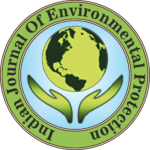IJEP 41(3): 325-332 : Vol. 41 Issue. 3 (March 2021)
Sekar Priyanka, Sreekumari Venugopal Athira, Raghupathy Shreeyashwanth and Anbu Aravazhi Arunkumar*
Karpagam Academy of Higher Education, Department of Biotechnology, Coimbatore – 641 021, India
Abstract
Nanoparticles are usually synthesized from metals, such as silver, gold, platinum, copper and zinc. There are several methods used for the synthesis of nanoparticles, such as physical, chemical and biological. People all over the world use different kinds of personal care products (PCPs), like soaps, sunscreen lotions, hair styling products, hair removers, shampoos, conditioners, moisturizers, anti-agers, nail and cuticle care products, oral care including toothpaste and whiteners. Curry leaves are part of a regular diet in India and many parts of the world, it may also serve as a possible nutritional intervention and the extract itself or fractions obtained there from may be used also as a future nutritional supplement to combat oxidative stress-induced tissue damage in the people exposed to lead. Plant mediated synthesis of silver nanoparticles and the study of their size and properties are of fundamental importance in the advancement of recent research. The size and shape of the nanoparticles form a basis for the wide variety of applications. In the present study, biosynthesis and characterization (UV-visible spectroscopy and FTIR) of green nanoparticles from aqueous extract of curry leaves (Murraya Koenigii) and coriander leaves (Coriandrum sativum) was performed and the same was subjected to adsorption studies for wastewater treatment to find out the optimum pH, dosage and time of action for effective removal. The initial absorbance value of household wastewater was 0.788. After treating with zinc nanoparticle synthesised from curry and coriander leaf extract was found to be 0.422 and 0.615, respectively. In this, Murraya koenigii (curry leaves) proves more efficient for treating household wastewater.
Keywords
Wastewater, Nanoparticles, Curry leaves, Coriander leaves, FTIR, Adsorption
References
- Ashtaputrey. 2017. Green synthesis and characterization of copper nanoparticles derived from Murraya koenigii leaves extract. J. Chem. Pharmaceutical Sci., 10(3): 1288-1291.
- Goutam. 2017. Coriander extract mediated green synthesis of zinc oxide nanoparticles and their structural, optical and antibacterial properties. J. Nanosci. Tech., 3(1): 249-252.
- Siregar. 2017. Characteristics and free radical scavenging activity of zinc oxide (ZnO) nanopar-ticles derived from extract of coriander (Corian-drum sativum L.). Terakreditasi. 17(3): 144-150.
- Agrawal, S. 2018. Silver nanoparticles and its potential applications. J. Pharmacognosy Phyto-chem., 7(2): 930-937.
- Kulkarni, V. 2015. Coriander leaf extract is efficient biocatalyst for synthesis of copper nano-particles. Chem. Xpress. 8(2): 127-132.
- Krishnaveni, B. 2014. Biosynthesis and antimicrobial activity of silver nanoparticles from Murraya koenigii, Ocimum teniflorum, Chitin and Chitosan. Int. J. Pharmaceutical Biol. Archives. 5(1): 49-55.
- Deb, S. 2014. Synthesis of silver nanoparticles using Murraya koenigii (green curry leaves), Zea Mays (baby corn) and its antimicrobial activity against pathogens. Int. J. Pharm. Tech. Res., 6(1): 91-96.
- Mollick, M. R., et al. 2019. Studies on green synthesized silver nanoparticles using Abelmoschus esculentus (L.) pulp extract having anticancer (in-vitro) and antimicrobial applications. Arabian J. Chem., 12(8): 2572-2584.
- Gosh, D. 2012. Protective effect of aqueous leaf extract of Murraya koenigi against lead induced oxidative stress in rat liver, heart and kidney: A dose response study. Asian J. Pharmaceutical Clinical Res., 5(4).
- Kumar, S. 2015. Synthesis of silver nanoparticles from curry leaf (Murraya koenigii) extract and its antibacterial activity. CIB Tech. J. Pharmaceutical Sci., 4(2): 15-25.
- Nisha, K. 2017. Biosynthesis of silver nanoparticles from Murraya koenigii and its application in effluent treatment. European J. Pharmaceutical Medical Res., 4(7): 514-518.
- Kinani, B. H. A. and L. A. Almashhedy. 2017. Biosynthesis of copper nanoparticles using Coriandrum sativum L. ethanolic extract. Der. Pharma. Chem., 9(6): 109-118.
- Ravulapalli, S., et al. 2010. Biosynthesis of silver nanoparticles using Coriandrum sativum leaf extract and their application in nonlinear optics. Adv. Sci. Letters. 3(2): 138. DOI: 10.1166/asl.2010.10 99.
- Alaqad, K. 2016. Gold and silver nanoparticles: Synthesis methods, characterization routes and applications towards drugs. J. Env. Analytical Toxic., 6(4): 1-10.
- Giraldo, L. 2013. Magnetite nanoparticles for removal of heavy metals from aqueous solutions: Synthesis and characterization. Adsorption. 19: 465-474.
- Datta, A. 2017. Green synthesis of zinc oxide nanoparticles using Parthenium hysterophorus leaf extract and evaluation of their antibacterial properties. J. Biotech. Biomater. DOI:10.4172/21 55-952X.1000271.
- Devatha, C. P., A. K. Thalla and S. Y. Katte. 2016. Green synthesis of iron nanoparticles using different leaf extracts for treatment of domestic wastewater. J. Cleaner Production. 139: 1425-1435.
